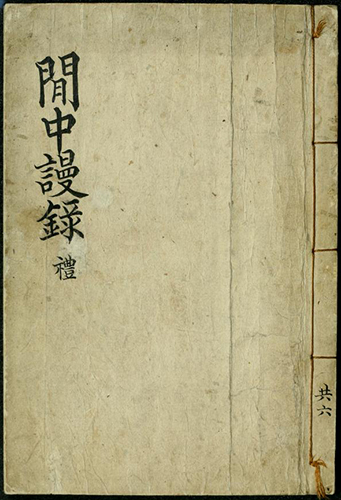17 Korean

This manuscript consists of four autobiographical narratives written by Lady Hyegyŏnggung Hong Ssi, an 18th-century Korean noblewoman. Considered both a literary masterpiece and an invaluable historical document, the memoirs were translated into English by JaHyun Kim Haboush with the title The Memoirs of Lady Heygyŏng (Berkeley: University of California Press, 1996).
A story is told through personal anecdotes, written between 1795 and 1805, of Lady Heygyŏng’s life in the palace and about tragic happenings to members of her family. She was married to the crown prince of King Yŏngjo (1694-1776; reigned in 1744-1776). In the summer of 1762, her husband and apparent heir to the throne was falsely accused of plotting against Lady Heygyŏng’s father, and was placed in a sealed rice chest in which he suffocated. Soon after this tragedy, King Yŏngjo regretted his harshness and gave his daughter Hong Ssi the title of Royal Consort Hyegyŏnggung.
Historical and modern linguists classify Korean as a language isolate with linguistic roots in Manchuria. Prior to 1433/34 when King Sejon of the Chŏsun Dynasty invented the remarkable alphabet known to southerners as hangŭl and to northerners as chŏsongŭl, all writing in Korea was done in the Chinese script.1 In the 17th century, it evolved into modern Korean, with considerable phonological differences from Middle Korean.2 Rather than being composed in literary Chinese as were most writings by men before the modern era, Lady Heygyŏng’s memoirs were composed in Korean, in han’gŭl script, making them accessible to the modern reader.
As the official language of both South and North Korea, Korean is the native language of more than 77 million people worldwide.3 The Library’s Korean holdings exceed 102,000 volumes. Outstanding among these are the 4,000+ volumes of the Asami library, assembled by Asami Rintarō in the early decades of the 20th century and purchased by the Library thirty years later.4 In 1942, UC Berkeley became the first university in the country to offer instruction in Korean, which continues to be taught for all academic levels in the Department of East Asian Languages and Cultures.
Contribution by Jaeyong Chang
Librarian for the Korean Collections, C.V. Starr East Asian Library
Sources consulted:
- Garry, Jane, and Carl R. G. Rubino. Facts About the World’s Languages: An Encyclopedia of the World’s Major Languages, Past and Present. New York: H.W. Wilson, 2001.
- Dalby, Andrew. Dictionary of Languages: The Definitive Reference to More Than 400 Languages. New York: Columbia University Press, 1998.
- Ethnologue: Languages of the World (accessed 6/3/19)
- UC Berkeley Center for Korean Studies
Title in English: Memoirs Written in Silence
Author: Hyegyŏnggung Hong Ssi (1735-1815)
Imprint: Korea : [s.n., 18–?]
Edition: 1st
Language: Korean
Language Family: Koreanic
Source: The Internet Archive (UC Berkeley)
URL: https://archive.org/details/handyungmannokkw01asam/mode/2up
Select Print editions at Berkeley:
Handyung Mannok: Kwŏn 1-6. Korea: publisher not identified, 1800. East Asian Rare ASAMI 22.29 1-6
The Memoirs of Lady Hyegyŏng: The Autobiographical Writings of a Crown Princess of Eighteenth-Century Korea. Translated into English by JaHyun K. Haboush. Berkeley: University of California Press, 1996. Also available as an ebook.

